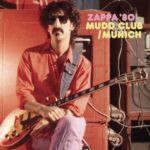For those attracted to numbers, this latest archival set- direct from Zappa’s famed Vault- carries special significance. It is, officially, the 125th release of the late artist’s career. Roll that around a bit: 125 official releases. What is as astounding is how little retread there is among the 125; how little filler and/or compilations are in there padding out the stats. And, it’s because of the unique place that each one of the 125 holds -as another piece of the Zappa jigsaw- that keeps a fanbase eager to slot it into the puzzle; one move closer to complete.
So how is this one unique?
First, it’s a three-CD set of two separate shows from a 1980 Spring tour that featured a very short-lived lineup, including Dave Logeman on drums, holding down that all-important chair in the Zappa ensemble between stints with the masterful Vinny Colaiuta. Logeman survived a grueling audition and his reward was anchoring a sextet that also showcased Ike Willis and Ray White on guitars and vocals, as well as Tommy Mars on keyboards and Arthur Barrow on bass. It’s an exceptionally nimble unit, designed to appropriate the flash of New Wave that was rising with the dawn of the new decade; turning “Easy Meat” into a hyper and stylistic rendition suitable for the times, as but one example.
The first show, contained on a single disc, is from New York City’s Mudd Club, a tiny dance dive that Zappa liked enough to fashion a song about it- “Mudd Club,” naturally- tattooed with a reggae groove and spoken-word lyrics honoring its dinge. This was an early May show, ahead of the European run that provides the Munich concert on discs two and three, and feels like, at an hour’s length, a tidy warm-up. The close proximity of walls to audience to band lends a defined immediacy to the fidelity of both the group and the recording; at one point Zappa asks, “Is it too loud?” Contrast the mere suggestion of a jam on the Mudd Club “Pound for a Brown” with the extended 13-minute workout by Mars and Zappa on the Munich take for an obvious difference in approach and execution.
The Munich performance- the first Zappa show to be captured digitally- is the full regalia; with the band polished and the space primed for generous exploration. There are two encores- mainly a run of tunes catering to Zappa’s doo-wop inclinations- as well as plenty of room for Zappa’s guitar. Speaking of, on both shows Zappa’s axe is mixed way, way up; the tone, snarling and biting and beastly, and matching the increasingly profane lyrics Frank was finding more and more appealing (decades ahead of a cancel culture that most certainly would’ve challenged him). “City of Tiny Lites” roars as a 10-minute centerpiece for Zappa’s virtuosity.
All in all, #125 has earned its place among the dozens as a necessary and illuminating listen from a band that otherwise logged such a short stay on the Zappa timeline, with a pair of performances that demonstrate the always-evolving flexibility of Frank and his stellar group of players.



No Comments comments associated with this post